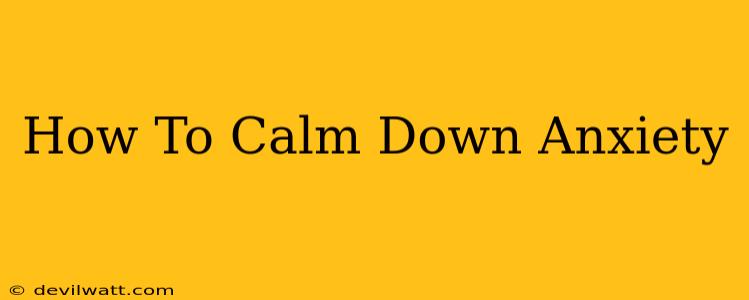Anxiety. That unsettling feeling of unease, worry, and nervousness that can creep into our lives and disrupt our peace. It's a common experience, but learning how to calm down anxiety is a crucial skill for maintaining well-being. This guide provides practical techniques to help you manage and reduce anxiety symptoms, empowering you to reclaim your sense of calm.
Understanding Your Anxiety Triggers
Before diving into calming techniques, understanding what triggers your anxiety is essential. Keep a journal to track your anxiety levels throughout the day, noting situations, thoughts, and feelings. Identifying patterns can reveal your personal anxiety triggers, allowing you to develop proactive coping strategies. Common triggers include:
- Stressful events: Deadlines, arguments, major life changes.
- Specific situations: Public speaking, social gatherings, enclosed spaces.
- Physical factors: Lack of sleep, poor diet, caffeine.
- Negative thoughts: Worrying about the future, dwelling on the past.
Powerful Techniques to Calm Anxiety Immediately
When anxiety strikes, these techniques can provide immediate relief:
1. Deep Breathing Exercises
Deep, slow breathing is a cornerstone of anxiety management. Diaphragmatic breathing, also known as belly breathing, slows your heart rate and activates your parasympathetic nervous system (responsible for relaxation).
- How to: Sit comfortably, place one hand on your chest and the other on your belly. Inhale deeply through your nose, feeling your belly rise. Exhale slowly through your mouth, feeling your belly fall. Repeat for several minutes.
2. Progressive Muscle Relaxation
This technique involves systematically tensing and releasing different muscle groups in your body. By releasing physical tension, you can alleviate mental tension as well.
- How to: Start with your toes, tensing them for 5 seconds, then releasing for 30 seconds. Gradually move up your body, tensing and releasing each muscle group (calves, thighs, abdomen, chest, shoulders, neck, face).
3. Mindfulness Meditation
Mindfulness encourages focusing on the present moment without judgment. By observing your thoughts and feelings without getting carried away, you can reduce the intensity of anxious thoughts. There are many guided meditations available online or through apps.
4. Grounding Techniques
Grounding techniques connect you to the present moment through your senses. When overwhelmed by anxiety, focus on:
- Sight: Describe five things you see.
- Sound: Name four things you hear.
- Touch: Identify three things you can feel.
- Smell: Describe two things you smell.
- Taste: Name one thing you taste.
Long-Term Strategies for Anxiety Management
While immediate techniques provide relief, long-term strategies are crucial for sustained well-being:
1. Regular Exercise
Physical activity releases endorphins, which have mood-boosting effects. Aim for at least 30 minutes of moderate-intensity exercise most days of the week.
2. Healthy Diet
A balanced diet rich in fruits, vegetables, and whole grains can improve your overall mood and reduce anxiety symptoms. Limit processed foods, caffeine, and alcohol.
3. Sufficient Sleep
Aim for 7-9 hours of quality sleep each night. Establish a regular sleep schedule and create a relaxing bedtime routine.
4. Cognitive Behavioral Therapy (CBT)
CBT is a type of therapy that helps you identify and challenge negative thought patterns contributing to anxiety. A therapist can guide you through techniques to reframe your thinking and develop healthier coping mechanisms.
When to Seek Professional Help
If your anxiety is significantly impacting your daily life, don't hesitate to seek professional help. A therapist or counselor can provide personalized support and guidance in managing your anxiety effectively. Remember, seeking help is a sign of strength, not weakness. You deserve to live a life free from the overwhelming grip of anxiety.

